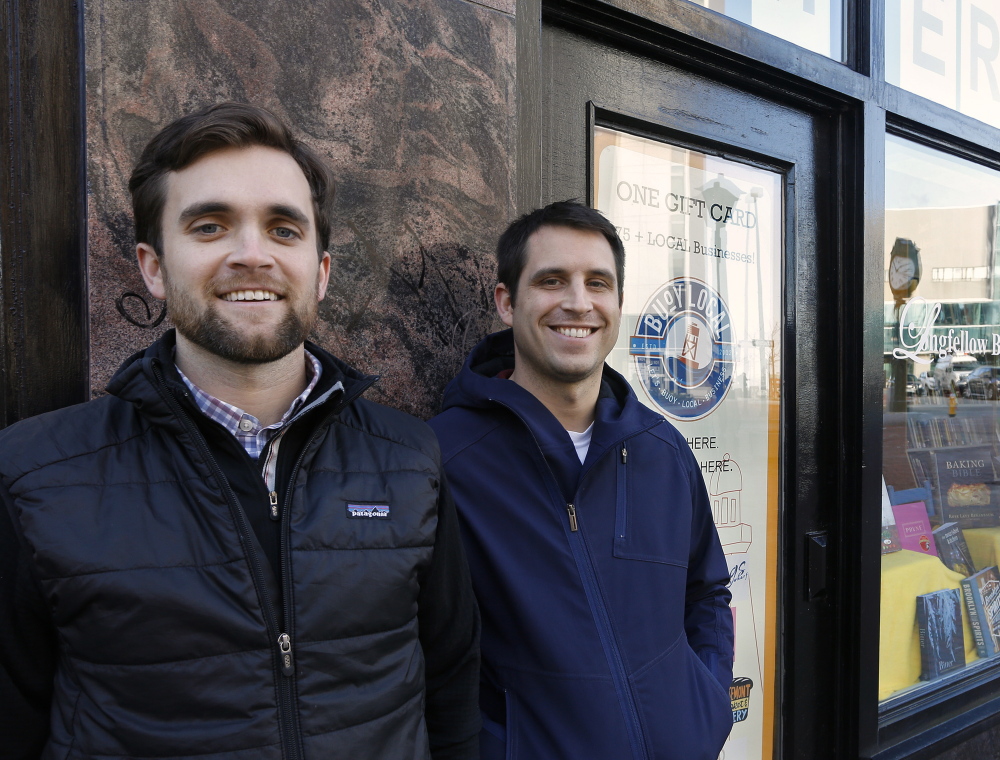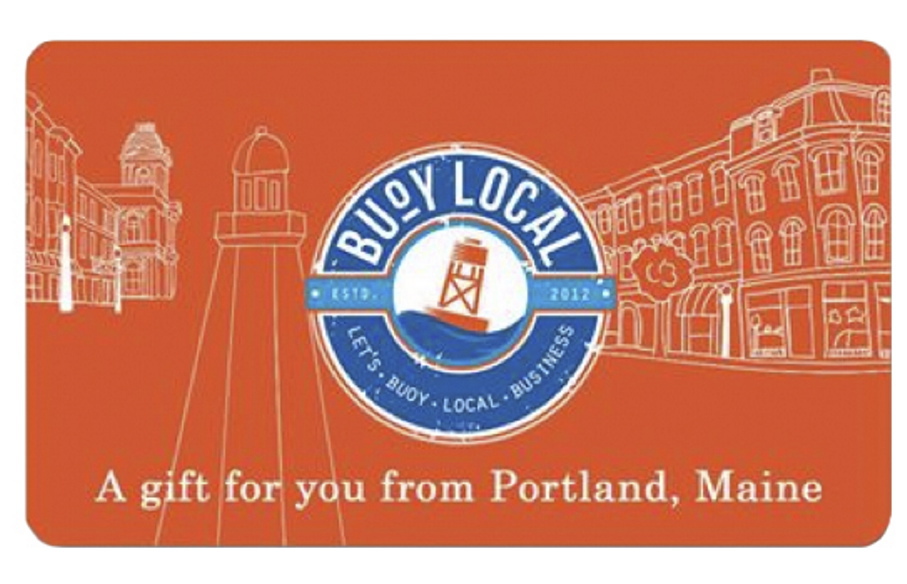Click to access interactive data
Kai Smith and Sean Sullivan have a penchant for keeping retail dollars in Greater Portland.
So even though the economic impact of buying local is well-researched, they were surprised by the success of their first full year of offering a local gift card through their company, Buoy Local. They launched Buoy Local in November 2013 with a goal of selling $100,000 worth of gift cards – and surpassed that by nearly 50 percent. Between Nov. 30, 2013, and Dec. 31, 2014, they sold $145,000 worth of gift cards redeemable at businesses in Greater Portland.
Encouraged by their first-year performance, they are considering expanding in 2015. “This is not just novel or cute,” Sullivan, 30, said of the program. “This is real, quantifiable economic development.”
The results have validated their belief that a buy-local gift card – unlike the gift cards for national chains like Best Buy and Gap that are ubiquitous at retail checkout lines – is attractive to the shopping public and would drive sales to local merchants. So far, gift-card holders have used their cards more than 2,500 times to spend roughly $60,000 at over 95 participating merchants in Greater Portland. And Sullivan and Smith say the company’s data suggests the use of its gift cards spurs additional spending.
A major plank of Buoy Local’s marketing platform is that every $100 spent at a locally owned business contributes an additional $58 to the local economy, compared with just $33 if that same $100 is spent at a non-locally owned chain store in Portland, according to a 2011 report by the Maine Center for Economic Policy. That same $100 spent at an online retailer like Amazon provides no local economic impact.
The policy center’s study concludes that if residents were to shift 10 percent of their spending from chains to locally owned businesses, it would generate $127 million in additional local economic activity and 874 new jobs.
That spending shift is what Smith and Sullivan set out to do.
“It’s a creative way to have economic development,” said Smith, a 29-year-old MBA student at the University of Southern Maine. “The problem with economic development efforts across the board is they’re often throwing all their eggs in one basket.”
Given the nature of their business, the partners are well-equipped with the hard data to measure that impact, and help their merchants measure it too.
For example, in roughly 20 percent of purchases using Buoy Local gift cards, the entire amount on the card was redeemed in a single transaction. That indicates the card likely was used to buy an item more expensive than the card’s value, said Smith and Sullivan.
In the wider gift-card industry, data shows that when the entire amount of a gift card is used in a single transaction, there is additional spending that equals an average of 20 percent of the gift-card value. So, for example, when a $100 gift card is used in a single transaction it would result in a purchase valued, on average, at $120.
RESTAURANT LIKES SIDE BENEFIT
Still, $60,000 is a tiny sliver of total annual spending at downtown businesses, and the amount of data per merchant is even smaller. So Aaron Pastor, director of operations at Binga’s Wingas, which has locations in Portland and Yarmouth, is cautious about drawing too many conclusions about how participating in Buoy Local’s program has helped his restaurant.
“I’d like to think it helps, but I can’t tell you unequivocally it has driven ‘X’ percent of increased business,” Pastor said.
Sales using Buoy Local gift cards were higher than the enrollment fee that Binga’s paid to be accepted into the program, but without more legwork, such as conducting customer surveys, Pastor thinks it would be impossible to determine whether the restaurant’s Buoy Local sales were additions or would have been generated anyway.
Although increasing sales is certainly an objective, it’s not the only positive outcome that Pastor expects from Buoy Local. Being recognized as a locally owned restaurant is just as important to the business, he said.
“Because of its size and scope and location near (Cross Insurance Arena), there are times it’s perceived as something other than what it is,” Pastor said, suggesting many people think Binga’s Wingas is a national chain. “So being part of Buoy Local has value to us to make the public aware we’re just a little bit bigger, but still have the personal touch of the local business.”
Even without knowing whether it brought in new customers and resulted in higher sales, Pastor didn’t hesitate to re-sign with Buoy Local for another year.
“It’s pretty awesome that we can present a positive public image and also take in money from it, rather than putting an advertisement in the paper not really knowing what effect that has,” he said.
POST-HOLIDAY SPENDING POWER
The gift cards also have had ancillary benefits, said Smith and Sullivan. For example, the majority of the cards are purchased during the holiday season and given as gifts, with the result that spending continues after Christmas. For example, participating restaurants – including Local 188, Empire, El Rayo Taqueria and Salvage BBQ – rang up more than $9,000 in sales from Buoy Local cards in the two weeks after Christmas, roughly 15 percent of all spending by gift-card holders for the past year.
The company is profitable, but Smith and Sullivan have yet to draw any sort of personal salary, choosing instead to reinvest the profits in the business.
That’s not to say the first year was without its challenges.
One aspect of the business they decided to rework is how they charge merchants to participate. Buoy Local does not make money from taking a small percentage from each transaction like credit card companies do. Instead, merchants are charged enrollment and annual fees.
Last year, merchants paid an enrollment fee ranging from a few hundred dollars to $750, based on the number of employees. But the pair changed that fee structure, shifting the determining factor from a company’s size to how much it benefits from the Buoy Local program.
“Now that we’ve been able to track results for a year and see how different businesses perform, we realized it would be better to link the fees paid to results seen,” said Sullivan, who is also director of the Maine Brewers’ Guild. “We also realized that we need to tie our business model to the redemptions of our cards, in order to scale our revenues in proportion to our success.”
Going forward, businesses interested in participating will pay a $200 enrollment fee and a $100 flat fee the first year. For all years after that, they’ll pay a $200 fee plus an additional fee equal to 20 percent of the previous year’s total return (the amount of Buoy Local-facilitated sales minus the enrollment fee).
EXPLORING NEW WAYS TO GROW
Smith and Sullivan are not resting now that their gift card has gained some traction. They’re already looking for other ways they can serve their customers, and gain new ones.
They were both recently accepted into the competitive Top Gun program for entrepreneurs run by the Maine Center for Entrepreneurial Development. The five-month program combines in-person classes with ongoing mentorship for entrepreneurs with promising startups or business ideas.
One potential opportunity is finding a way to monetize the enormous amount of data that Buoy Local is collecting on buy-local trends.
The partners also will try to make the gift cards more ubiquitous. Although the holiday season has fueled Buoy Local’s growth, they realize that for the card to really scale up, they have to break the notion that it’s just a holiday-focused product.
Another idea is to migrate the program to other cities, but for now the pair is focused on Portland.
Growth is in the future, “but only in a way that’s paced to retain our authenticity,” Sullivan said.
Send questions/comments to the editors.



